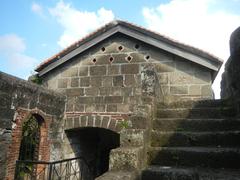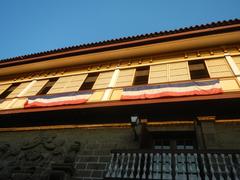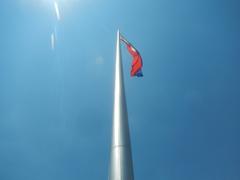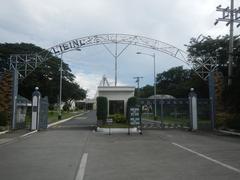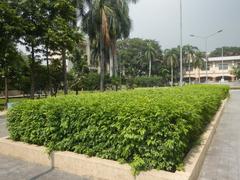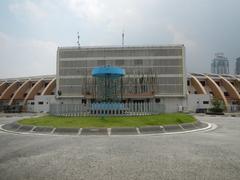Visiting Hours, Tickets, and Historical Sites: Guide to The Life and Heroism of Gat Andres Bonifacio, Taguig, Philippines
Date: 22/07/2024
Introduction
Andres Bonifacio, often celebrated as the ‘Father of the Philippine Revolution,’ remains a towering figure in the annals of Philippine history. His indomitable spirit and unwavering commitment to the cause of independence have left an indelible mark on the nation’s collective memory. From his humble beginnings in Tondo, Manila, to his pivotal role in the formation of the Katipunan and the subsequent Philippine Revolution, Bonifacio’s life is a testament to the power of resilience and patriotism.
The ‘Life and Heroism of Gat Andres Bonifacio’ exhibit in Taguig offers visitors a unique opportunity to delve deep into the life and legacy of this national hero. Located in the vibrant Bonifacio Global City (BGC), the exhibit is a rich tapestry of interactive displays, historical artifacts, and multimedia presentations that illuminate Bonifacio’s journey from a self-educated youth to a revolutionary leader. Whether you are a history enthusiast, a student, or a casual visitor, this exhibit promises an immersive and educational experience that brings the past to life.
This guide aims to provide comprehensive information for prospective visitors, including historical insights, practical travel tips, and detailed visitor information. By exploring the life and contributions of Andres Bonifacio, we hope to foster a deeper appreciation for the sacrifices made in the pursuit of Philippine independence, and inspire a renewed sense of national pride and heritage.
Table of Contents
- Introduction
- Historical Background
- Visiting the ‘Life and Heroism of Gat Andres Bonifacio’ Exhibit in Taguig
- FAQ
- Conclusion
Historical Background
Early Life of Andres Bonifacio
Andres Bonifacio, born on November 30, 1863, in Tondo, Manila, is often referred to as the ‘Father of the Philippine Revolution.’ He was the eldest of six children in a modest family. His parents, Santiago Bonifacio and Catalina de Castro, were both of humble origins. Despite financial hardships, Bonifacio was able to educate himself through self-study, reading books on the French Revolution, biographies of U.S. presidents, and novels such as ‘Les Misérables’ by Victor Hugo (National Historical Commission of the Philippines).
Formation of the Katipunan
In 1892, Bonifacio founded the ‘Kataas-taasan, Kagalang-galangang Katipunan ng mga Anak ng Bayan’ (KKK), commonly known as the Katipunan. This secret society aimed to gain independence from Spanish colonial rule through armed revolt. The Katipunan was inspired by the ideals of liberty, equality, and fraternity, similar to the principles of the French Revolution (Philippine Revolution Web Central).
The Cry of Pugad Lawin
One of the most significant events in the history of the Katipunan was the ‘Cry of Pugad Lawin’ in August 1896. During this event, Bonifacio and his fellow revolutionaries tore their ‘cedulas’ (residence certificates) as a symbol of their defiance against Spanish rule. This act marked the beginning of the Philippine Revolution (Official Gazette of the Republic of the Philippines).
The Battle of San Juan del Monte
The first major battle led by Bonifacio was the Battle of San Juan del Monte on August 30, 1896. Although the Katipunan forces were ultimately defeated, this battle signified the start of a nationwide uprising against Spanish colonial forces. Bonifacio’s leadership and bravery during this battle earned him the title ‘Supremo’ or supreme leader of the Katipunan (National Historical Commission of the Philippines).
Internal Conflicts and the Tejeros Convention
Despite his leadership, Bonifacio faced internal conflicts within the Katipunan. The most notable of these was the Tejeros Convention held on March 22, 1897. During this assembly, a faction led by Emilio Aguinaldo questioned Bonifacio’s leadership and eventually elected Aguinaldo as the president of a new revolutionary government. Feeling betrayed, Bonifacio declared the election null and void, leading to further divisions within the revolutionary movement (Philippine Revolution Web Central).
Arrest and Execution
The internal strife culminated in Bonifacio’s arrest in April 1897. He was charged with sedition and treason against the revolutionary government led by Aguinaldo. After a controversial trial, Bonifacio and his brother Procopio were sentenced to death. On May 10, 1897, they were executed in the mountains of Maragondon, Cavite (Official Gazette of the Republic of the Philippines).
Legacy and Commemoration
Despite his tragic end, Bonifacio’s legacy as a revolutionary leader endures. He is commemorated annually on Bonifacio Day, a national holiday in the Philippines celebrated every November 30. Numerous monuments and landmarks, including the Bonifacio Monument in Caloocan and the Andres Bonifacio Shrine in Manila, stand as testaments to his enduring influence on Philippine history (National Historical Commission of the Philippines).
Visiting the ‘Life and Heroism of Gat Andres Bonifacio’ Exhibit in Taguig
The ‘Life and Heroism of Gat Andres Bonifacio’ exhibit in Taguig is a tribute to Bonifacio’s contributions to the Philippine Revolution. Located in the Bonifacio Global City (BGC), this exhibit offers visitors an immersive experience into the life and times of one of the Philippines’ most revered national heroes. The exhibit features interactive displays, historical artifacts, and multimedia presentations that provide a comprehensive overview of Bonifacio’s life, from his humble beginnings to his role in the revolution (Bonifacio Global City Official Website).
Visitor Information
- Operating Hours: The exhibit is open daily from 9:00 AM to 6:00 PM. It is advisable to check the official website for any changes in schedule or special events.
- Admission Fees: There is a nominal entrance fee, with discounts available for students, senior citizens, and groups.
- Guided Tours: Guided tours are available and highly recommended for a more in-depth understanding of the exhibits. These tours are conducted by knowledgeable guides who provide valuable insights into Bonifacio’s life and the historical context of the revolution.
- Accessibility: The exhibit is wheelchair accessible, and there are facilities available for visitors with disabilities.
- Photography: Photography is allowed, but the use of flash and tripods is prohibited to preserve the integrity of the artifacts.
- Souvenirs: A gift shop is available on-site, offering a range of souvenirs, books, and memorabilia related to Andres Bonifacio and the Philippine Revolution.
Travel Tips and Nearby Attractions
- Nearby Attractions: While in Taguig, visitors can also explore other historical sites such as the Manila American Cemetery and Memorial, as well as modern attractions like the Mind Museum.
- Transport: Public transportation options are available, including buses and jeepneys. Ride-hailing services like Grab are also convenient ways to reach the exhibit.
- Dining: BGC offers a wide range of dining options, from local eateries to international restaurants, making it easy to plan a full day’s visit.
Special Events and Photographic Spots
- Special Events: The exhibit occasionally hosts special events, lectures, and workshops related to Philippine history and Bonifacio’s legacy. Check the official website for upcoming events.
- Photographic Spots: The exhibit and surrounding areas in BGC offer numerous spots perfect for photography. Don’t miss the chance to capture the Bonifacio Monument and other significant landmarks.
FAQ
- What are the visiting hours for the Andres Bonifacio exhibit? The exhibit is open daily from 9:00 AM to 6:00 PM.
- How much are the tickets for the Andres Bonifacio exhibit? There is a nominal entrance fee, with discounts available for students, senior citizens, and groups.
- Is the exhibit wheelchair accessible? Yes, the exhibit is wheelchair accessible, and facilities for visitors with disabilities are available.
- Can I take photos inside the exhibit? Yes, photography is allowed, but the use of flash and tripods is prohibited.
Conclusion
By visiting the ‘Life and Heroism of Gat Andres Bonifacio’ exhibit, tourists can gain a deeper appreciation of the sacrifices and contributions of one of the Philippines’ most iconic national heroes. Whether you are a history enthusiast or a casual visitor, this exhibit offers a unique and educational experience. Don’t miss out on this opportunity to explore the life and legacy of Andres Bonifacio. For more information, check out the official website and plan your visit today.
Call to Action
Stay updated on the latest events and exhibits by following us on social media and visiting our website. Download the mobile app Audiala for an enhanced experience and exclusive content on Philippine history. Explore more related articles on our site, and immerse yourself in the rich heritage of the Philippines.
References
- National Historical Commission of the Philippines. (n.d.). https://nhcp.gov.ph
- Official Gazette of the Republic of the Philippines. (n.d.). https://www.officialgazette.gov.ph
- Philippine Revolution Web Central. (n.d.). http://www.philippinerevolution.net
- Bonifacio Global City Official Website. (n.d.). https://bgc.com.ph

